A spreadsheet is one of the most popular tools in managing a restaurant. Restaurants have a vast amount of data that needs to be tracked in different time intervals. For that reason, Excel is a necessary resource used by all levels of management.
Using Excel for restaurants means the data you input has to be clear and concise. Inaccurate data can lead to poor decision making. In addition, top level management usually does not want to delve into details of a report. They would like to see the data in top performance indicators to be accurate.
In this article, we’ll be discussing which components of restaurant operations need Excel, the pros and cons of using Excel for restaurants, and at what point should you consider transitioning to a restaurant management system.
Excel for Restaurants: 8 Most Common Cases
There are multiple cases wherein the use of a restaurant Excel sheet is important in food business operations. Here are examples of restaurant management cases that will always require spreadsheets.
Inventory
For restaurant inventory management Excel is a go-to solution for many restaurants. It is mostly common to use Excel for restaurants if the business is still small and the volume of data isn’t yet huge.
Two separate workbooks are usually created to track a restaurant’s inventory. The purpose of the first book is for monthly inventory checking. This is where you’ll be able to calculate your COGS for the previous month.
The second book is to track your daily inventory. In this workbook, you’ll be able to track the usage per day of a certain ingredient. An ordering template is usually created on the daily inventory sheet where important data like ending inventory for a certain day and usage for a week or two is available.
Continue on below to see examples of these Excel files we’ve mentioned above.
Monthly Inventory File

Let us break down each section of the Monthly Inventory Sheet shown above.
The first column simply identifies the product name via a number. Some restaurants input the SKU code or create their own unique number for it. The second column simply shows the name of the raw material used in the restaurant.
The third and fourth columns give as purchased information regarding the raw material. After this, you input the actual counts of your beginning inventory, purchase, and ending inventory. The amount is simply the unit cost multiplied by the actual inventory count on the previous columns. The last column COGS is computed by the formula – (Beginning + Purchases) – End.
Daily Inventory File
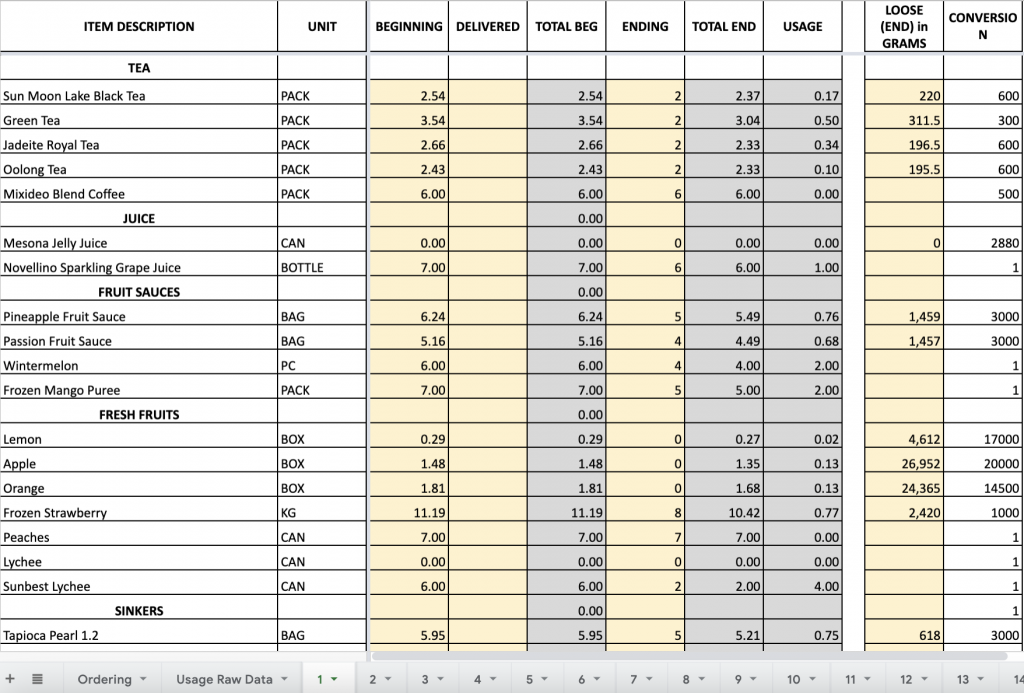
An Excel spreadsheet for restaurant inventory will consist of 28, 29, 30 or 31 tabs, depending on which month it is. The main idea is to input the ending inventory on each day of the month which corresponds to the tabs on the sheet.
For example, today is January 14 and it is time to input your daily inventory account. Go to tab “14” and update accordingly. It is important to note that each day prior to 14 must be updated to have accurate results.
Purchasing
In line with a restaurant’s inventory sheet is their purchasing sheet. Restaurants make use of Excel to track all purchases in a certain time period.
Here’s an example of a purchasing template per month.
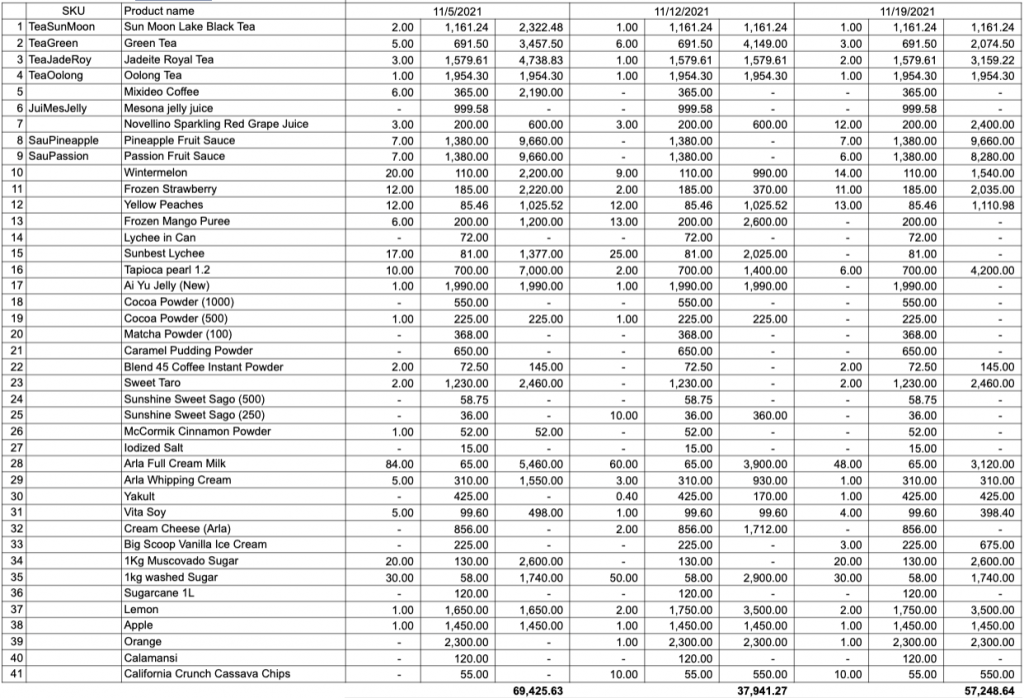
In the template shown above, the top row is meant for the date in which the purchases were made. On the columns below the date, the left side shows the purchase count for a certain raw material. The column in the middle represents the unit price of the item while the rightmost column is the total purchase amount for that date. Copy and paste these 3 columns to the side – you can add more if you have lots of purchases for a certain period of time.
Sales Tracker
Aside from costs, Excel for restaurants can also be used to manage the sales numbers. Excel can calculate the total invoices on a certain day and have a summarized sheet for the total daily, weekly, monthly sales figures.
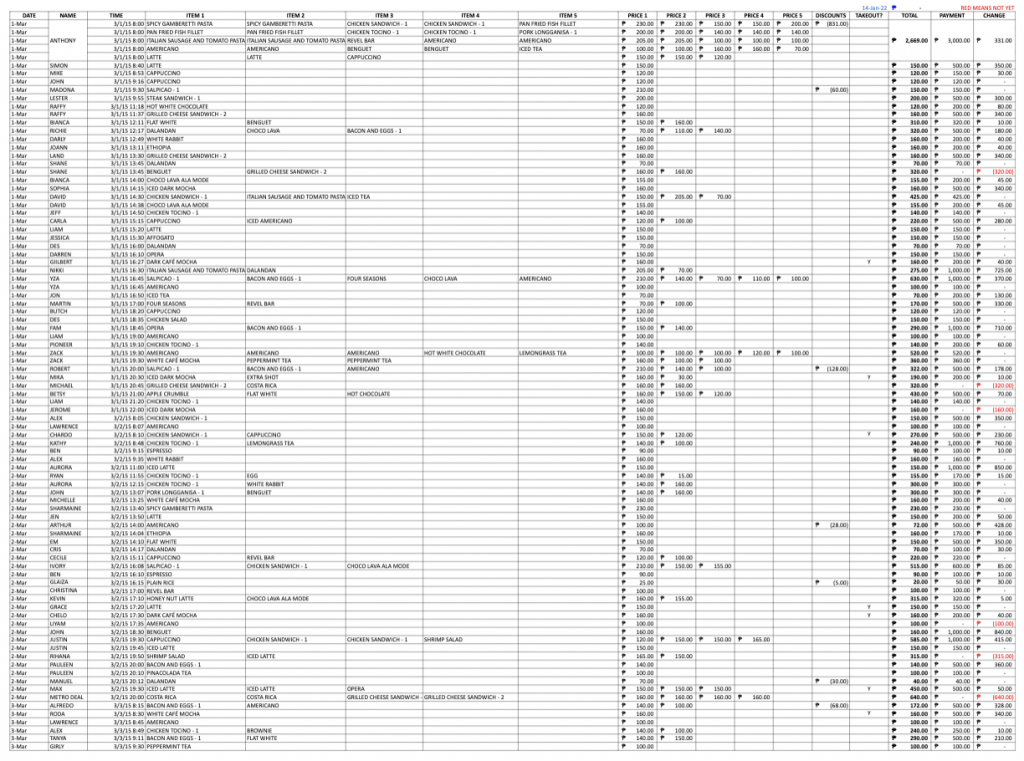
Recipe Costing
Excel has the capability to calculate the Cost of Goods of your restaurant. Important data points are weight of the recipe, unit of measure, conversion, price per pack, and price per KG. With this data, you can get the recipe cost of your products and manage your Excel restaurant menu with ease.

Profit Margins and Percentages
When you know the cost of your recipes, you can also calculate your profit margins and percentages.

The example above shows the selling price and cost per product. If restaurant owners want to calculate gross profits, profit margin, and food cost percentage formula Excel will be of huge help with its basic formulas.
Food Cost Percentage: (Cost divided by Selling Price) x 100%
Gross Profit: Selling Price minus Cost
Profit Margin: 100% minus Food Cost
Employee Schedules
Creating the employee schedule on Excel gives the restaurant a quick overview on who and how many get to work a certain day. Added details such as shift, number of employees on a certain shift, and number of rest days should also be in the Excel file.

Payroll
One of the most important uses of Excel for restaurants is payroll. With so many variables like overtime pay, night time differential, holiday pay, and rest day premiums, it is ideal that Excel helps with all of these calculations. In addition, the Payroll file can also serve as your 201 file for your employees where all their basic information is stored.

Wastages
Restaurants need to keep track of their wastages or their COGS might shoot up. Having an Excel file ready to track your food wastage will help limit them. Items which are high in waste often can be monitored and have some modifications done to the production or the recipe.
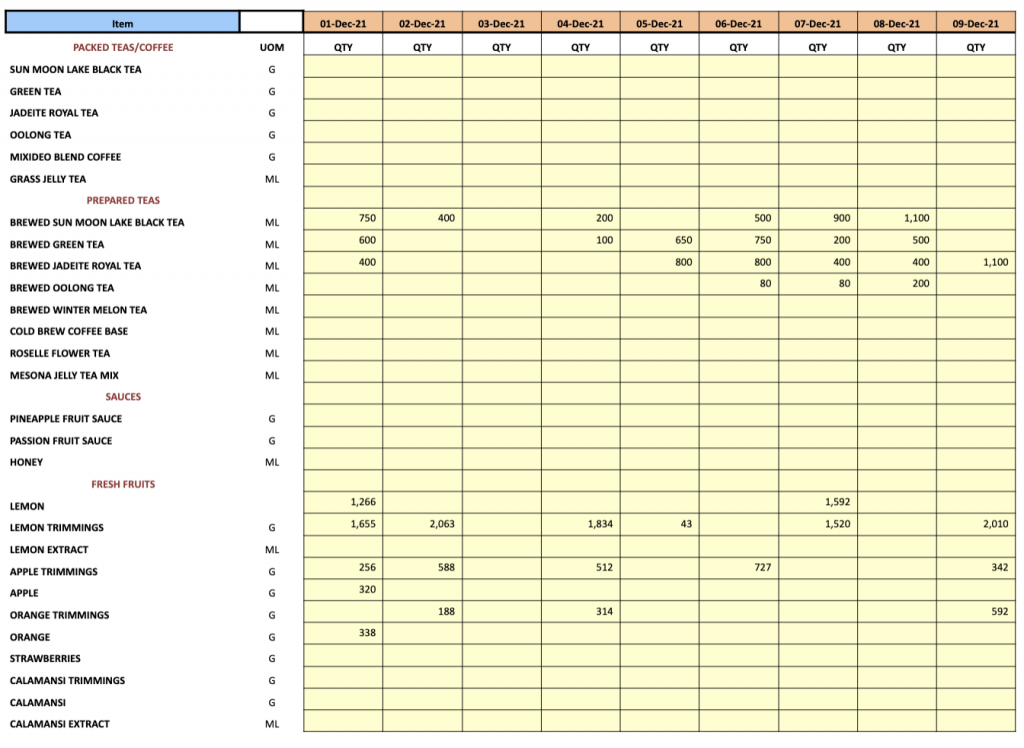
Profit & Loss Statements
When managers want to track restaurant profit and loss statement Excel is again a good solution. It has lines for each important row item in the P&L.
See example below.

Is Excel Really a Good Solution for Restaurants?
Restaurants need high level information in order to make key decisions. Choosing the right tools can help restaurant owners make the right decision for the company. However, despite the help Excel brings to the table, it still has lots of limitations. A restaurant who has high aspirations in the scene might look to invest in a more worthwhile solution.
With that said, do you think Excel is considered as the right tool for restaurants? Do the pros outweigh the cons?
Let’s break down the pros and cons of using Excel for restaurants.
Excel for Restaurants: Pros
- Minimal cost. Microsoft Excel entails you to have a yearly subscription for both Windows and Mac users. On the other hand, the use of Google Sheets is free for all users.
- Basics are easy to learn. If you’re familiar with basic math, there’s no doubt that you can use it for some calculations in Excel. There are also multiple videos on Google and YouTube if you’re looking for a tutorial.
- Readily available templates to use.
- Visualize your data with charts feature.
Excel for Restaurants: Cons
- Too much data on a worksheet lowers productivity. When Excel has huge data sets, it takes a LOT of time to load.
- A stand-alone application. It is not integrated with other business software so it is not easily accessible to all members of your team.
- Easy to manually change data. There have been instances where fraud has been committed where numbers have been changed to reflect an undervalued amount. Excel basically has no protection for these kinds of situations.
- Microsoft Excel cannot do automatic reporting. The data is usually based on the numbers you’ve input on the same or different sheet.
- Using Microsoft Excel is prone to human error.
- Taking full advantage of Excel requires learning advanced formulas. This takes a lot of time that restaurant owners usually don’t have.
What Does it Take from Restaurants to Switch from Excel to RMS?
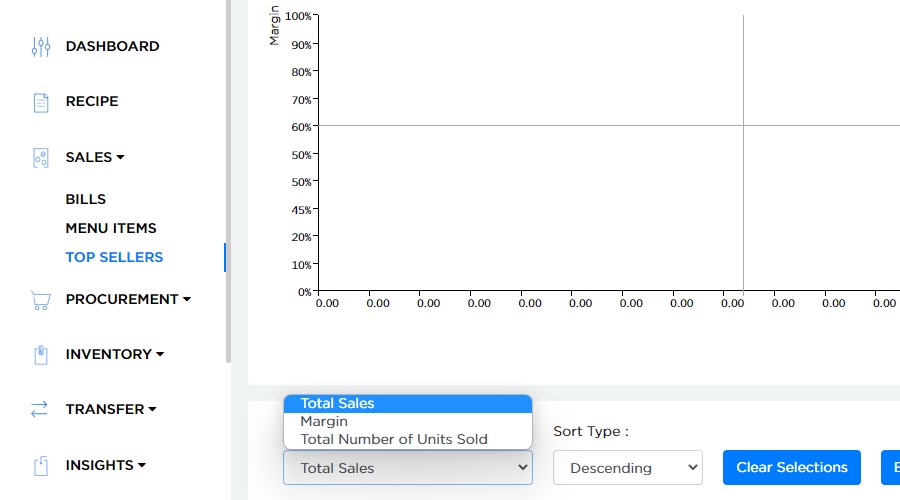
The main difference between RMS and Excel for restaurants is that RMS will automate the operations of the restaurant. Some people believe that Excel saves you time but it actually takes your time. Despite the designs and formulas, some cells will still need manual encoding. This will require more hours on your end.
Here are some FAQs when switching from Excel to RMS.
FAQ 1: How will switching from Excel to RMS affect inventory?
A: RMS can manage your stocks in real-time. No need to manually input inventory nightly.
FAQ 2: Will I still need to input data manually?
A: Yes. However, this will be reduced to a minimum. Repetitive and manual tasks will be automated by the RMS.
FAQ 3: The formulas in Excel for restaurants help but one error skews the whole worksheet. Will I prevent this with an RMS?
A: RMS gets data from your POS. It can automatically generate reports and definitely prevents human error in data gathering.
How to Choose an RMS (Restaurant Management System)
A RMS is a unified platform that helps organize and manage all the back-end operations of a restaurant. In order to choose the right restaurant management system for your restaurant, proper research is necessary. It will take time but it will help you make the correct decision.
First, you need to research the correct type of RMS for your restaurant. It’s either a front of house RMS or a back of house one. Second, you have to check if the features are what you need for your restaurant. The most common features that an RMS has are Recipe Management, Purchasing Management, Staff Management, Inventory management, and more.
Third, it is important to see which ones are cost-friendly and have the most value for money. Lastly, take time to see if the RMS you’re looking at has ample support. There are companies that have self-service platforms while others have a full team who offer customer support. Make sure that these companies who offer full support make your list.
How to Migrate Data from Excel to RMS
There are multiple modules available for restaurant management software. There’s an inventory module, a staff scheduling module, and a payroll module, to name a few. All of these modules tend to have an import option from Excel so the work won’t be repetitive.
The import process usually requires users to have their Excel file in csv or comma-separated values. In addition, RMS usually has a set template on how the columns must be organized in order to import correctly.
See an example below on importing a staff scheduling file to a Payroll software.
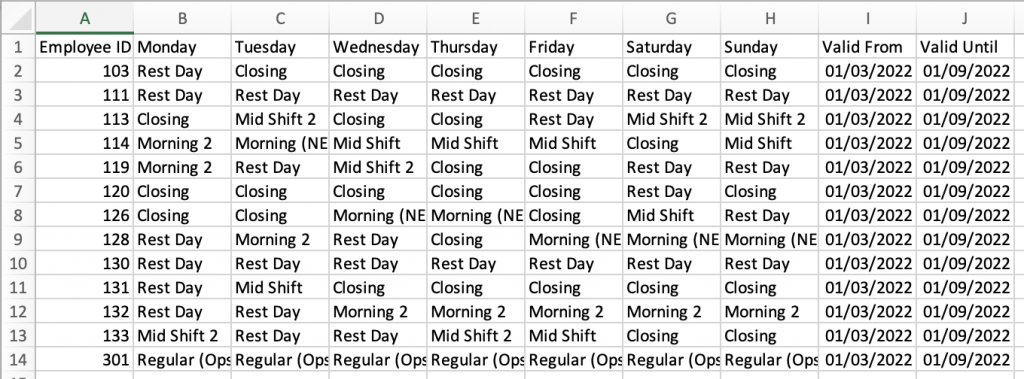
Column A is meant for the employee ID you’ve entered into the system. Columns B-H represents days of the week (Monday – Sunday) and you have to input their respective shifts in the row with their employee ID. Lastly, Columns I and J represent the dates of Column B-H. The dates should be in a format that the system will allow. In this case, it’s “mm/dd/yyyy”.
How to Train the Team to Use the New Solution
After choosing your RMS, it is important that your whole team knows how to use it. RMS companies usually have an onboarding session for its new partners.
For EagleOwl, they have a team dedicated to enhancing user experience. The EagleOwl team is available via email, phone, FreshChat, and their social networks (Facebook, Twitter and LinkedIn). The team is available from 10AM-7PM (GMT+5:30) daily from Monday-Saturday. However, they are available anytime when the issue is urgent. In addition, video calls via Google Meet or Zoom is also an option given by EagleOwl.
EagleOwl also has a dedicated YouTube channel to teach new partners on how to maximize their software. They have videos on how to create supplier contracts, how to take stock manually, link a menu item to a recipe, and much much more. If you want to learn more about EagleOwl, the videos are definitely a good start.
Final Thoughts
Excel for restaurants is a good tool that you can use to manage the business. It might be difficult and tedious to use Excel at times but it does the job nonetheless.
On the other hand, a restaurant management system is a tool that encompasses every aspect of the business. Once you’ve decided to use a RMS for your restaurant, be patient and compare every quote that you receive from a solutions company. Make sure that it has the features that you’re looking for and it fits the budget you’re working with. In short, using a RMS can help simplify the management part of the business and it can give you time needed to focus on business development and operations of your restaurant.
Learn how to grow with EagleOwl. Our restaurant management system can help optimize your finances and increase your restaurant’s net profit by at least 25%. Contact us now to schedule a free demo!
